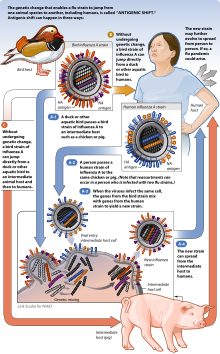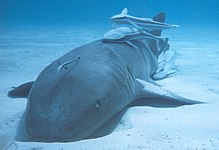Host (biology)
For example trout and salmon are sometimes said to be "primary hosts" for salmonid whirling disease, even though the myxosporean parasite reproduces sexually inside the sludge worm.One example is the buff ermine moth whose larvae feed on alder, mint, plantain, oak, rhubarb, currant, blackberry, dock, ragwort, nettle and honeysuckle.There is a trade off between offspring quality and quantity; the specialist maximises the chances of its young thriving by paying great attention to the choice of host, while the generalist produces larger numbers of eggs in sub-optimal conditions.The host provides a protected environment in a well-lit position for the algae, while benefiting itself from the nutrients produced by photosynthesis which supplement its diet.[24] Lamellibrachia luymesi, a deep sea giant tubeworm, has an obligate mutualistic association with internal, sulfide-oxidizing, bacterial symbionts.Such crops as beans, peas, chickpeas and alfalfa are able to fix nitrogen in this way,[28] and mixing clover with grasses increases the yield of pastures.[31][32] Remoras (also called suckerfish) can swim freely but have evolved suckers that enable them to adhere to smooth surfaces, gaining a free ride (phoresis), and they spend most of their lives clinging to a host animal such as a whale, turtle or shark.[33] Many molluscs, barnacles and polychaete worms attach themselves to the carapace of the Atlantic horseshoe crab; for some this is a convenient arrangement, but for others it is an obligate form of commensalism and they live nowhere else.[34] The medieval Persian physician Avicenna recorded human and animal parasites including roundworms, threadworms, the Guinea worm and tapeworms.[34] In Early Modern times, Francesco Redi recorded animal parasites, while the microscopist Antonie van Leeuwenhoek observed and illustrated the protozoan Giardia lamblia from "his own loose stools".






black ratreservoir hostbubonic plaguerat fleasvectorsbiologymedicineorganismparasiticmutualisticcommensalistsymbiontanimalsnematodespathogenicvirusesnitrogen-fixing bacteriabotanyfood resourcesevolutionarily stableectoparasitismSymbiosisparasitismcommensalismmutualismparasitoidpredationherbivorybrood parasitismcuckooMicropredatorparasitepredatorstrategiesevolutionary strategieshost–parasite coevolutiongene polymorphismsDirofilaria immitissalmonidwhirling diseasemyxosporeansludge wormtrichinosisroundwormsmusclesdevelopment cycleAlaria americanamesocercarialtadpolessnakesSkrjabingylus nasicolaWest Nile virusculicinemosquitoespathogendiseaseBuff erminecaterpillarLarval food plants of Lepidopteraevolutionarily stable strategyplantsherbivorousmonophagoussilkwormmulberrydiamondback mothbrassicaspotato tuber mothSolanaceaepolyphagousplantainrhubarbcurrantblackberryragwortnettlehoneysuckleInfluenzasecondary metaboliteshawthorn-carrot aphidhawthorncarrot familyepidemiologyantigenic shiftsinfluenza vaccineviral strainMutualism (biology)Mycorrhizamutualistic interactiontermitesprotozoacellulosegut floradigestionzooxanthellaephotosynthesisLamellibrachia luymesihermit crabsspongeleguminous plantsrhizobiachickpeasalfalfaclovergrassestyramineProvidenciaCaenorhabditis elegansoctopamineCleaning symbiosisHawaiian cleaner wrasseyellowtail wrasseCleaner fishNurse sharkcommensalremorasa free ridePhoresis (biology)phoresiscopepodscommon remoramolluscsbarnaclespolychaete wormsAtlantic horseshoe crabhuman parasites